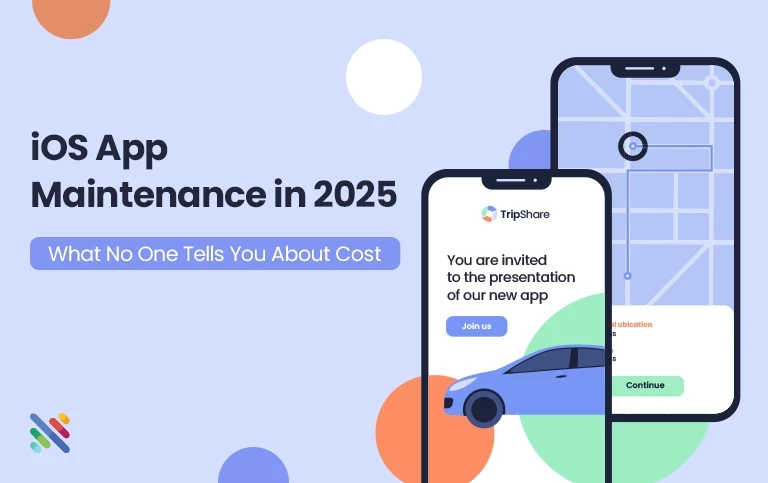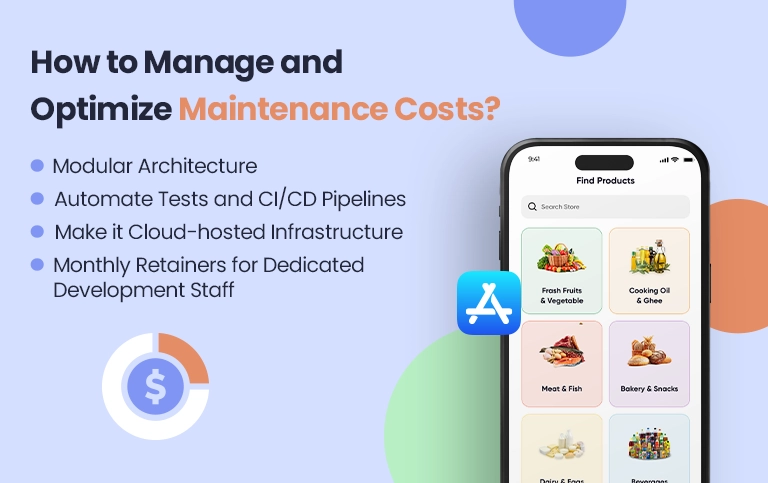
iOS App Maintenance in 2025: What No One Tells You About Cost
Releasing an iOS application in 2025 is the first step of your mobile journey, after which the challenges and costs come thick and fast. This is where the cost of mobile app maintenance in 2025 for iOS comes in. Astonishingly, app maintenance is usually one of the most neglected parts by many businesses, only to find themselves staring at huge bills and compliance issues along the way.
This guide is a thorough explanation of maintenance pricing that covers what it really costs to maintain an iPhone app, the changing profiles of iOS app support and maintenance, and the hidden costs of compliance with the rules and regulations on the Apple App Store that you are probably not prepared for.
Understanding the mobile app maintenance 2025 landscape is not just a matter of saving money; it's about preparing for the journey ahead. Whether you are a startup founder, CTO, or a digital product manager, a comprehensive understanding of the mobile app maintenance 2025 landscape can potentially save you thousands of dollars from unexpected delays. Now let’s delve into the details.
The Basics About iOS App Maintenance Cost in 2025
You have spent months creating a masterpiece: an app that is beautiful and usable and has finally been approved by Apple. But here is the twist: development is only half the battle. In fact, some app maintenance services account for 15-25% of an app's total development cost annually, depending on the complexity and number of users.
Why Are Maintenance Costs on the Rise in 2025?
The iOS ecosystem as of 2025 is undergoing change at a never-before-seen rapid rate. With newer AI-enhanced security protocols, the demands for richer app experiences, and a plethora of updates to iOS, your app would need to make constant adjustments.
Here are some core reasons why the iOS app maintenance cost in 2025 is on the rise:
- Frequent iOS version updates
- Modifications to Apple App Store policies
- Demands for bug resolution
- Security vulnerability patches
- Testing of device compatibility (for new iPhones, iPads)
- Updating of third-party SDKs
- Analytics on user behavior and maintenance of A/B testing
By understanding and planning for these costs, you can take control of the life cycle of your mobile apps and potentially save significant amounts. These costs must not be ignored, but with proactive management, they can be minimized, empowering you to make informed decisions and save on unnecessary expenses.
Breakdown of App Maintenance Pricing in 2025
Understanding app maintenance pricing is crucial as it will help you budget wisely and provide a clear picture of how your money will be spent.
Maintenance Task | Estimated Monthly Cost (USD) | Notes |
Regular bug fixing | $500 – $1500 | Depends on the complexity and user feedback |
Security updates | $300 – $800 | Critical to stay on top of Apple’s security guidelines |
Compatibility testing | $400 – $1000 | New devices and iOS updates |
UI/UX enhancements | $1000 – $3000 | Based on user insights and heatmaps |
Backend server costs | $100 – $2000+ | Scales with usage |
Third-party API updates | $300 – $700 | Pay attention to SDK changes |
Total | $2600 – $9000+/month | May vary significantly |
Practice on Test Data Through October in the Year 2025
The cost of maintaining an iPhone app in the year 2025 could range from about $30,000 to more than $100,000 a year, depending on the scale and requirements of the app.
Costs that no one would care to discuss
On top of the usual line items in your invoice are surreptitious additional costs, usually shocking product owners:
Apple App Store Compliance Cost
Apple regularly revises its privacy policies, standards for designs, and security expectations. Failure to adhere to these can end up with your app being delisted or your users losing trust in it. Alterations in the policies require updates to your UI, T&C, or user tracking preference.
Estimated Annual Cost: $2000 - $5000+ according to frequency of changes.
Bug Fix iOS Apps After Launch
Despite thorough testing before launch, bugs will inevitably be discovered. However, fast and regular bug fixing is the key to maintaining a high-quality app and retaining users. This ongoing process should reassure you about the quality of your app.
Tip: Hire mobile developers on retainer for speedy bug resolution.
Cost for iOS Updates
With Apple's faster update cycles, keeping up is costly. The cost of iOS updates encompasses code refactoring, additional UI features, and QA testing.
Estimated Annual Cost: $4,000 - $10,000+
The Effect Maintenance Will Have on the Lifespan of Your App
Mobile app maintenance in 2025 is a marathon, not a sprint. The relevance of your app depends on how well you are evolving it over time.
Key Lifecycle Milestones Affected by Maintenance
- Retention: Better maintenance = fewer crashes = higher user retention
- Revenue: Updates can introduce fresh revenue models in time.
- Brand perception: A well-maintained app signals professionalism and credibility.
- Security: Regular patching will keep user data safe and compliant.
If maintenance is neglected, it significantly reduces the ROI of a mobile app lifecycle cost
How to Manage and Optimize Maintenance Costs?
So now that we are clear on likely challenges, let's see how to optimize your iOS App Maintenance Cost 2025 without compromising quality.
Modular Architecture
The architecture should be modular for your iOS app. This will allow you to make focused updates instead of redoing a large work of rewritten code.
Automate Tests and CI/CD Pipelines
Set up CI/CD pipelines that offer efficiency in pushing updates as soon as a minor bug fix occurs. This should minimize human testing overhead through automation.
Make it Cloud-hosted Infrastructure
Cloud platforms like AWS and Firebase take care of all backend costs easily and scale automatically, giving downtime and maintenance loads less weight.
Monthly Retainers for Dedicated Development Staff
By 2025, the increasing trend will be to have dedicated mobile app development personnel work with you in the long term. This way, you benefit from having faster bug fixes and cheaper rates per month. In addition, these familiarized personnel will have in-depth knowledge of your code base.
Easily hire iOS application developers from reputable development companies with flexible engagement models.
Who Should Manage App Maintenance?
The continuous upkeep can now be managed through the following:
In-house Team
Positive:
Total control
Time responsive
Negative:
Huge salary overheads
Not scalable for startups
Hire Dedicated Developers via Agencies
Good:
Budget-friendly
Cross-functional expertise
Downsides:
Torture to vet
Communication hurdles (if offshore)
Want a faster scale-up? Hire app developers with extensive iOS experience for maintenance and support.
App Care Services
Most agencies now provide an independent service for app maintenance: You have to pay only for what you require, whether bug-fixing, updates, monitoring, or compliance.
Emerging Trends That Affect iOS App Maintenance in 2025
Tech trends will keep you in anticipation of your next purchase.
Enhanced Privacy Regulations
Countries across Europe, Asia, and the Middle East are enforcing stricter user privacy norms. This means your app would require localized mechanisms for data handling, which only adds to the cost of iOS updates and compliance fees.
AI-Based Personalization
Incorporating AI for real-time recommendations or tracking user behavior would need constant upgrades and model retraining. That's more weight on your app maintenance pricing.
Foldable iPhones and Wearable Integration
UI compatibility testing will get tougher, as new types of screens will be presented for iPhones and a deeper invasion for Apple Watch will be introduced. So add this to your cost to maintain the iPhone app.
Cloud-Native App Architectures
More applications are moving over to cloud-native stacks like Firebase, Supabase, or AWS Amplify to save infrastructure costs in the long term.
Case in Point: Scaling a Finance App
This personal finance tracking iOS app goes live in terms of funding at $100,000 just before becoming available for general download in early 2024. By mid-2025, you will be fortunate enough to attract 100,000 users.
Without proper maintenance:
- The iOS 18.3 update will miss.
- The app crashes for 30% of users.
- App Store reviews nosedive.
- Apple flags you for data policy violations.
- Revenue drops by 40% within 2 months.
Now contrast this with a strategy where you would hire iOS application developers for continued support, bring in the analytics, and frequently invest in bug-fix iOS app maintenance.
You stay compliant with an ever-changing Apple monopoly while scaling up to 250,000 users, much more trusted by users, and with revenue.
To Conclude
For sources that won't provide highly complex data, it will be plan ahead or pay later. Maintenance is no longer an optional feature; it is an integral investment for the future of your application. It is clear by this point that the cost of maintenance for an iOS app in 2025 won't just cover bugs but includes proactive expenses for security, legal compliance, performance monitoring, and enhancements to user experience.
Whether it's through app maintenance services, hiring app developers, or keeping it in-house, the key is always consistency, transparency, and agility.
Final Pro Tips:
- The annual budget is 15-25% of the initial app cost for maintenance.
- Create monthly or quarterly reviews.
- Updates shall be based on analytics, not guesswork.
- Don't delay! One feature out of date may result in rejection from the App Store.
Need help managing your iOS app over the long haul? You can hire dedicated developers or look into iOS app development services that include maintenance plans. ''Smart'' investment now saves headaches later.
FAQs
Q: What is the average maintenance cost for an iOS app in the year 2025?
A: It ranges from $2,500 to $9,000/month, depending on app complexity, features, and user base.
Q: What activities are included in the iOS app support and updates?
A: Routine bug fixes, compatibility testing, user interface improvements, security patches, and compliance with Apple Store updates.
Q: How much does bug fixing cost for an iOS application?
A: Bug fixing varies from US$500 to $1500 per month, depending on how responsive your support team is.
Q: How can I reduce the price of maintaining my app by outsourcing?
A: Yes, especially when you hire dedicated mobile app developers through trusted agencies.
Q: How can I optimize the cost of iOS app maintenance?
A: You can optimize costs by using modular architecture, automating testing, leveraging cloud hosting, and hiring dedicated developers on retainer for continuous support.
Q: Why are iOS app maintenance costs rising in 2025?
A: Increased iOS version updates, security patches, bug fixes, and compatibility testing for new devices are key factors driving up app maintenance costs in 2025.
Q: What’s the impact of poor app maintenance on user retention?
A: Poor maintenance can lead to crashes, security issues, and missed updates, which hurt user retention, brand perception, and revenue, ultimately impacting ROI.






